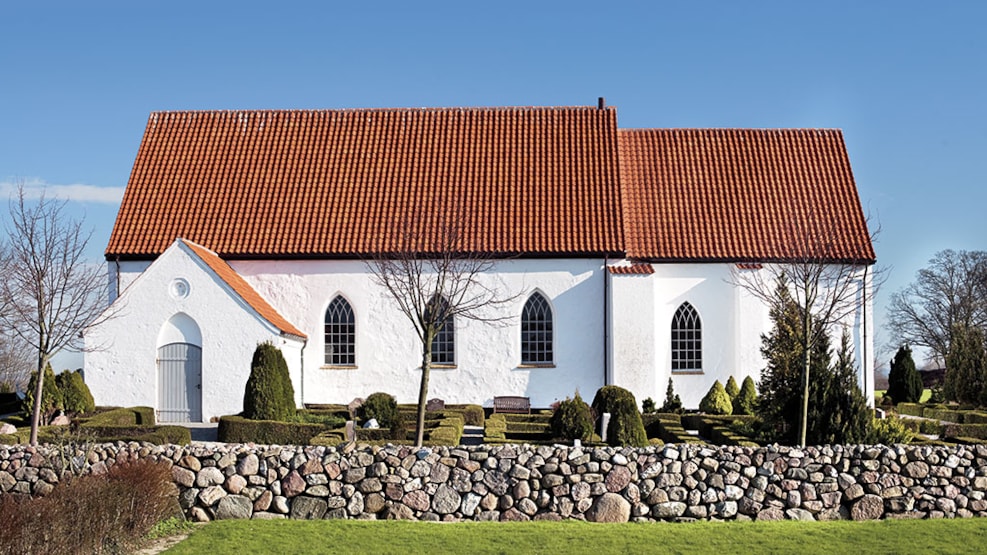
Glud Church
In the village of Glud by Horsens Fjord, you find this Romanesque church from around the year of 1200, which, for several hundred years, was owned by the Glud family. The church contains beautiful church art from many centuries as well as several references to the Glud family. The church is open to visitors during working hours of the church staff.
Romanesque church in holiday country
Two kilometres south of Horsens Fjord, just between Horsens and Juelsminde, lies the village of Glud with 700 inhabitants. The small village, which today is characterised by tourism, has a history dating back to ancient times – and archaeological excavations have yielded several finds from the Iron Age. Undoubtedly, this place was even inhabited before the church was built in 1150. Likely, the site where the church stands today was used for worshipping the Norse gods in some type of wooden temple before Denmark was Christianised. It was during the period of 1150 to 1200 that the majority of the current Danish village churches were constructed.
Following the Reformation, the church, like most Danish churches, became property of the crown. It was, however, sold in 1693 to Jørgen Arenfeldt, estate owner of the local manor Jensgaard, who then transferred the church to priest Niels Sørensen Glud. Additionally, the Glud family purchased the manor in the 1700s, owning the church until 1951. Overall, it amounted to almost 300 years of ownership to the priest and estate owner family, who left significant marks on the local area.
Not until 1961 did the church become self-owned, which was unusually late for a Danish church.
About the church
Glud Church shows as a beautiful, whitewashed church that, visually, stands apart from other local churches by not having a tower. The old bell is placed in a bell frame next to the church. Legends tell a story about this bell. According to myth, the original bell was being transported by a ship, which unfortunately sank, leaving the bell lying somewhere on the seabed. Now, when ringing out the replacement bell today, it sounds mournful, as if saying: "Mi måg æ drownet, mi måg æ drownet!" ("My mate is drowned; my mate is drowned!")
The chancel and nave of the church are original, built in 1150, made of ashlar stones. During the Middle Ages, the porch was added. The timeline for the construction of the nave, chancel, and porch is typical for Danish churches – although towers were typically built at the same time as the porch.
The church interior itself is large and wide – the widest of the local area and it feels even larger due to the beam ceiling, which is quite low. Notable furnishings include the Romanesque triumphal arch from the 1100s, the large crucifix from the Middle Ages, and the beautifully crafted pulpit and altarpiece. Both the pulpit and the altarpiece were created by the renowned Horsens woodcarver Peder Jensen Kolding, who has adorned more than 25 churches in Kystlandet. Rich in beautiful detail, you can spend heaps of time admiring the impressive craftmanship.
On the wall are three memorial plaques, commemorating some of the Glud family members who not only owned the church, but also served as priests in it.
Outside is the old churchyard, where a large, beautiful portal from around the year of 1500 serves as the entrance. Here you find, among other things, the Glud family burial site.
While you are in the town of Glud
Today, Glud is probably best known for its museum, Glud Museum, which is an open-air museum, providing good insight into the village-way of life and its activities through time. Combining a visit to the church with a visit to the interesting museum is a must.
From Glud, you have the option of following the popular hiking route, the Fjordmino, or the cycling route Horsens Fjord to the ferry port of Snaptun and, subsequently, the island Hjarnø – or westwards towards Horsens.
More historical attractions
Kystlandet offers many exciting historical attractions, from ancient times to industrial history – from museums to buildings and attractions in nature. On this site, you find inspiration for historically interesting experiences near Horsens, Odder, and Juelsminde.